Global Youth Water Leaders Call for Urgent Water-Climate Action, Highlight Role of Sustainability Education in Statement to United Nations General Assembly; A Q&A with Diana Virgovicova, Stockholm Junior Water Prize Recipient
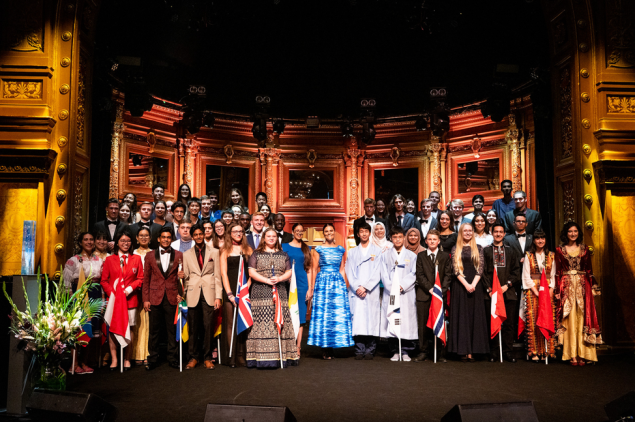 Bielawski & Virgovicova-JSE March 2020 Water and Climate Issue PDF
Bielawski & Virgovicova-JSE March 2020 Water and Climate Issue PDF
Link to JSE March 2020 Water and Climate Issue Table of Contents
Abstract: In this Q&A, Journal of Sustainability Education senior editor Amanda Bielawski interviews Diana Virgovicova, recipient of the 2019 Stockholm Junior Water Prize (SJWP). Virgovicova was among the SJWP recipients who recently issued a joint statement to the United Nations (UN) General Assembly that focused on the urgent need for water action, recognizing its intricate links to climate change. Rooted in the praxis framework, the joint statement focused on the critical role sustainability education, specifically, must and will play in turning scientific knowledge about the water-climate connection into actual action through policy change and other means. In this interview, Virgovicova underscored this point: “Education is the way to solve the water-climate sustainability crisis. We need to get more people involved. I think it is regrettable that environmental education is not a required assessment in schools.”
Keywords: Water; climate change; youth; United Nations; World Water Week; Stockholm Junior Water Prize
When globally-leading youth water scholars between the ages of 15 and 20 gathered for World Water Week in Stockholm in August 2019, a pressing shared concern emerged: the connection between water issues and climate change.Recipients of the 2019 prestigious Stockholm Junior Water Prize (SJWP) shared diverse experiences of how the water-climate nexus is playing out across the 35 countries they represent, such as intensified flooding in Latvia, water pollution concerns in Bangladesh and Mexico, and water scarcity and desertification in Israel. Recipients of the SJWP noted that, amidst climate change, “water affects our health, educational system, livelihoods, vulnerable populations, peace and also our future,” and also underscored that “access is privilege” (Stockholm International Water Institute [SIWI], 2019).
Recipients of the SJWP were so driven to have their voices heard globally on the water-climate connection, they issued a joint statement on the topic calling for urgent action that was ultimately presented at the United Nations (UN) General Assembly in September 2019. The full joint statement can be accessed here. The statement reads, in part, “What concerns us most is not only the inability of our individual countries to act, but how we will manage to summon global awareness, global engagement and global action” (SIWI, 2019a).

Figure 1. Stockholm Junior Water Prize Winners, representing 35 countries, pictured during World Water Week in Stockholm, Sweden, in August 2019. From: Jonas Borg, Stockholm International Water Institute.
The statement was first delivered at the Malin Falkenmark Young Scientist Symposium on Climate Change during World Water Week. Professor Falkenmark is a world-renowned expert on water at the Stockholm International Water Institute (SIWI) and recipient of the Blue Planet Prize. In her dedication to “handing over the baton of water wisdom to the new generation of water scientists, innovators, and decision-makers” (SIWI, 2019b), Falkenmark became a driving force in the creation of the youth symposium. According to SIWI, the youth water-climate symposium will continue during World Water Week in 2020.
Figure 2. The joint statement on the water-climate connection presented to the 2019 UN General Assembly by youth recipients of the Stockholm Junior Water Prize. From: Stockholm International Water Institute.
Specifically notable to the field of sustainability education, the joint statement called particular attention to the role both classroom- and community/policy-based education must play in future praxis—converting scientific understanding of the intricate links between climate and water into such aforementioned global action. The statement was, in fact, blatant on the topic of praxis, stating “the time for ‘raising awareness’ is over,” and, “we want to see theory being put into practice” (SIWI, 2019a). Specifically related to the role of sustainability education, the statement read:
We want interdisciplinary curriculums in schools to increase educational efforts on climate-change related knowledge to the general public and instill this knowledge bringing it to the core of the young generation. Investments in education and research are paramount to bringing the necessary innovations to reality in order to overcome today’s and tomorrow’s challenges. We must focus on sustainability and encourage climate sciences to break into the classical subjects of mathematics, chemistry, physics and social science, that are taught in schools, but are often taught separately and isolated without including or considering the impacts of climate change. So, whether we become an entrepreneur, politician, scientist, shopkeeper or farmer, we all know we have a responsibility, we all know we have a role to play. Climate change is a people problem. Governments, decision makers and institutions influence our behavior and, together or alone, institutions and individuals must be held accountable and responsible for a sustainable planet. If we don’t change nothing will. (SIWI, 2019a)
Figure 3. Sweden’s H.R.H. Crown Princess Victoria presents the Stockholm Junior Water Prize Diploma of Excellence to Dianna Virgovicova during World Water Week 2019. From: Jonas Borg, Stockholm International Water Institute.
In this Q&A interview, Journal of Sustainability Education (JSE) senior editor Amanda Bielawski sat down with Diana Virgovicova, recipient of the 2019 SJWP and the related Diploma of Excellence for her discovery of a photocatalyst that uses light waves to clean water. Together, they discussed the water-climate connection, the joint statement made to the UN General Assembly, and the youth water scholar’s view of the role of sustainability education in converting scientific knowledge into actual global water-climate action. In Virgovicova’s words, “Education is the way to solve the water-climate sustainability crisis. We need to get more people involved. I think it is regrettable that environmental education is not a required assessment in schools.”
Bielawski (JSE): First of all, congratulations on being awarded the 2019 Stockholm Junior Water Prize as the National UK Winner. And, additional congratulations for being awarded the 2019 Diploma of Excellence. How does it feel?
Virgovicova (SJWP Winner): “Thank you so much! I entered the Stockholm Junior Water Prize 2019 because I know that we are all dedicated to change the world and to make life better for our future generations. I am lucky that I could be part of such a big event before my 18th birthday. Winning the Diploma of Excellence and shaking hands with the Crown Princess Victoria of Sweden was the most incredible and emotional part of my academic life so far. I can say that the molecule which I discovered and SJWP 2019 changed my life. I believe that at the end of my journey there will be clean rivers in the world.”
Bielawski (JSE): For someone who may have limited scientific background related to water and climate science, and the connection between the two, could you explain how climate change impacts the water cycle?
Virgovicova (SJWP Winner): “It is straightforward. The overall effect is an intensification of the water cycle that causes more extreme droughts and floods all over the globe. Water evaporates from Earth’s surface, both land and sea. The water returns to Earth in the form of snow and rain. Climate change causes an increase in the temperature of the air. As the temperature rises, the rate of evaporation into the air increases. The warmer air can hold a higher amount of water vapor, and, as a result, massive rainstorms are causing extreme flooding in coastal regions all around the world. This can also have an opposite effect, as the evaporation increases with the raised temperature, the soil dries out. The dry hard soil is not able to absorb water, and the water runs off the ground into rivers and streams, and the soil remains dry. The result is an increased risk of drought. But it doesn’t end there. At the same time that some areas are experiencing stronger storms, others are experiencing more dry air and even drought. Like we mentioned above, as temperatures rise, evaporation increases, and soils dry out. When the rain pours down, much of the water runs off the hard ground into rivers and streams, and the soil remains dry. The result? Still more evaporation from the soil and an increased risk of drought.”
Bielawski (JSE): How did you become involved in water issues? What first inspired you?
Virgovicova (SJWP Winner): “In Slovakia, I come from a small, remote village, but this doesn’t stop me from having big dreams. It all started when I was 12. I noticed that something was wrong with our planet Earth. Global warming and dirty rivers. When I was 13, I traveled with my mum around India by train. We visited many places all over the country. In the suburbs of Mumbai, I saw black rivers and apprehended the reality of pollution. I started to think about the solution to this problem, which could save lives. I sent emails and letters to powerful and wise people like Stephen Hawking and the former president of France and asked them questions about what they were doing to preserve the world for us and the future generations. I realized that when my children will be my age, I want them to answer those questions differently. I want them to say: ‘I live on a planet with beautiful clean rivers.’”
Bielawski (JSE): What current water-related projects are you working on?
Virgovicova (SJWP Winner): At the age of 14, what I saw in my travels encouraged me to start working on my first research project. I created a small chemistry lab in my attic and equipped it with the glass from the school where my mother worked. I read about a substance called photocatalyst that absorbs radiation, produces hydroxyl radicals, and then eliminates organic pollutants in water. The product is clean drinking water. Now, I’m collaborating to commercialize this for industrial water treatment. The goal is to create sacks coated in my photocatalyst to purify water from viruses and bacteria for people in developing countries. The method is simple: the sack would be filled with polluted water, placed on the roof, and exposed to light. Time of purification would be under 30 minutes with a price less than 2 dollars and ready to use for 500 times. I will be testing my substance on E.coli and viruses after completing my A level exams. We will be testing the efficiency of my photocatalyst in the environment of viruses and bacteria. I want to study environmental engineering and I have applied to schools in the United States. I want to develop my project further, complete the testing on my photocatalyst, and implement it in real life as the part of everyday objects for people in developing countries.”
Bielawski (JSE): Last August, during World Water Week, you and your fellow SJWP winners developed a joint statement related to the water-related implications of climate change. This statement was ultimately presented during the UN General Assembly last September in New York. Tell us about how you and your SJWP colleagues feel about how pressing the issue of climate change impacting water security is.
Virgovicova (SJWP Winner): “We are students coming from all parts of the world, different backgrounds and cultures, 35 countries in total. Some of us experienced severe environmental problems and some of us have come from countries where the environmental issues are not as critical. Still, all of us agreed that the water in their country is either too much too little, or too dirty. Before coming to Stockholm, we talked about writing a statement which would raise the awareness on the environmental issues. We are living in the time of the environmental movement. But we still think that’s not enough. We want to see the acts which are making improvements. Because the future is forming now, not later, and there may not be any way back. Sadly and surprisingly, in this time full of modern technology and AI solutions on the one part of the planet, there are still people on the other one dying because of not having access to drinking water and drinking contaminated water daily. Statistics say that there are almost one billion people threatened by this, and in the future, due to population growth and climate change, this number will even increase. My 34 international friends and I came to Stockholm with the same aim. We are the representatives of young people who care about what is happening around us. We all wanted to try to find solutions to some of the most significant global water problems.”
Figure 4. The beginning of the joint statement on the water-climate connection presented to the 2019 UN General Assembly by youth recipients of the Stockholm Junior Water Prize. See the full statement here. From: Stockholm International Water Institute.
Bielawski (JSE): Can you tell a bit about the process of developing and presenting the joint statement that was ultimately sent to the UN General Assembly?
Virgovicova (SJWP Winner): “The first presentation of our statement was at World Water Week during the Malin Falkenmark Young Scientist Symposium on Climate Change, and later it was sent to the UN General Assembly. Our statement calls for action and a more solutions-oriented approach to the current crisis. We wrote about the importance of the science-based targets in both public and private policy. We also asked for increasing the amount of information and details the young people would get in schools. We pointed out the importance of having leaders, both political and influencers, who would embrace scientific thinking, not as an ideology, but as an effective platform to drive constructive discourse. I think that the opinions of the young generation are essential in the environmental movement. We grew up with the most modern technologies, and we may bring new views on how to solve global environmental problems. For instance, I used quantum chemistry software to solve one of the water challenges. In the future, we will be the ones who will face environmental issues. It is necessary to listen to us—young people—no matter how old we are. We need all opinions all views, we all need to be connected and contribute to the world around us. It is crucial to make a stronger community of people who believe in a better environment. Because the more powerful and more diverse we are, the more can be achieved and solved, and nothing else can win.”
Bielawski (JSE): The joint statement states: “Water affects our health, educational system, livelihoods, vulnerable populations, peace and also our future” (SIWI, 2019a). How well do you think the public understands the cross-cutting impact of water on society and how climate is impacting that?
Virgovicova (SJWP Winner): “I think that this depends on which part of the planet we are considering. For example, in some countries, there is a lack of understanding. Still, there are also countries where the population understands the cross-cutting impact of water on society. Three years ago, I visited China, Mongolia, and Russia. At that time, I was working on a project about global warming. I tried to take the opportunity to interview about 45 students who were volunteering with the restoration of the Terracotta Army in Xi’an, China. I was asking them specifically about environmental education in schools and whether they knew what environmental issues their country faces. The responses were similar. The majority of the university students claimed that there is a lack of understanding in this area, and the government censures all journals publishing information about the environmental crisis. On the same holiday, I visited the capital city of Mongolia, Ulaanbaatar, and talked to some local people about their feeling of water in their country. Mongolia is infamous for the fact that the population is drinking toxic water on a daily basis. The responses were shocking, with little understanding in the field of water quality. I am concerned about this shortage of understanding. Nowadays, sharing information and news is easier than ever before, and environmental education has to be an essential part of the general knowledge of each person living on our planet. There are many countries which are addressing water issues. I think that if those countries increased the spreading of their knowledge they gained on the way for a better environment with the countries that are just at the beginning of that way, the environmental movement would be much more significant and would bring more exceptional results in a shorter period.”
Bielawski (JSE): You spoke about the gap in understanding about water and sustainability issues. We are particularly interested to hear if you perceive a gap between how youth understand climate change and water—and how adults understand these issues.
Virgovicova (SJWP Winner): “There is a massive gap between the understanding of the environmental issues by young people and adults. From my perspective, the knowledge of the adults is much more influenced by the political opinions in their country, and the information they were gaining from media for years. I think that listening to the wrong ideas from politicians for years will make us believe in them. The result of it is the need for eagerness to change something because many people around us are using the word impossible very often. We, young people, who have been walking on the Earth’s surface for a shorter time, we still have a considerable amount of the eagerness to change and also a bit of naivety, which is extremely important. Having enormous goals for a better future of the next generation will bring us much more results than hiding from the truth.”
Bielawski (JSE): What did you learn about water and climate in your K-12/pre-college education? Was it enough for the time?
Virgovicova (SJWP Winner): “In my pre-college education, I have not learned well enough to understand what do the environmental changes around me mean. If I did not attend the Stockholm Junior Water Prize and did not work on the environment-related projects, I wouldn’t be able to consider the environmental issues our society faces fully.”
Bielawski (JSE): The joint statement spends a substantial paragraph focusing on the critical role of “investments in education and research” (SIWI, 2019a) in this sphere. Specifically, it states:
We want interdisciplinary curriculums in schools to increase educational efforts on climate-change related knowledge to the general public and instill this knowledge bringing it to the core of the young generation. Investments in education and research are paramount to bringing the necessary innovations to reality in order to overcome today’s and tomorrow’s challenges. We must focus on sustainability and encourage climate sciences to break into the classical subjects of mathematics, chemistry, physics and social science, that are taught in schools, but are often taught separately and isolated without including or considering the impacts of climate change. So, whether we become an entrepreneur, politician, scientist, shopkeeper or farmer, we all know we have a responsibility, we all know we have a role to play. (SIWI, 2019a)
Tell us more about the role you see education playing in this water-climate sustainability crisis.
Virgovicova (SJWP Winner): “Education is the way to solve the water-climate sustainability crisis. We need to get more people involved. I think it is regrettable that environmental education is not a required assessment in schools. We educate to make new leaders, engineers, and scientists. I think that environmental education should start as soon as we start with the simple calculations in mathematics. It is equally as important as that. I hope that there will be lessons focused on the environment connecting all sciences in one unit. The children would start learning from basics about how to recycle to tracking their carbon footprint. As the students would get older, the lessons would include multiple environmental disciplines. The result of this would be more young people fighting for the environmental movement, more environmental competitions, and more students willing to attend ecological courses at the university. While in school, the students usually decide about their careers. Having a teacher who motivates us to work can increase the passion for the given subject and the willingness to consider pursuing a career in that field. Having a teacher who cannot motivate, the teacher who teaches by way of memorization, and not actual understanding often means that the student loses his interest. A similar case is for environmental education. If we are not learning about it in schools and if we don’t understand the opportunities we may get in that area, then why should we study it?”
Bielawski (JSE): Do you have any recommended resources for educators who want to share information about the water-climate connection with their students?
Virgovicova (SJWP Winner): “I like the book Six Degrees: Our Future on a Hotter Planet by Mark Lynas. There are many official websites available I would also recommend such as Gizmodo’s Earther: Nature for Nerds; The Guardian’s Environment section and Inside Climate News. For students and even for little kids, one of my favorite environmental books is called One Plastic Bag: Isatou Ceesay and the Recycling Women of the Gambia.”
Bielawski (JSE): Thank you so much for your time. And, again, congratulations on the Stockholm Junior Water Prize. Is there anything else you’d like to add?
Virgovicova (SJWP Winner): “I am immensely grateful for this opportunity to share my ideas. I am also thrilled that there is an increasing number of people fighting for our blue planet Earth. We should make the promise that there will be able to give an environmental education in schools from the early stages. We should make the promise that the world leaders will be well educated with a willingness to help, improve, and save the environment. I would also like to share a short essay I wrote:
‘The winner of the Diploma of Excellence of the Stockholm Junior Water Prize 2019 is . . . the girl who has solved a long-lasting challenge by opening new windows in fundamental science combined with the most recent techniques within chemistry to formulate a novel molecule with high potential in promising future water treatment. Is that me? A girl originally coming from a tiny Slovak village surrounded by the Carpathian Mountains in the middle of nowhere? I was sitting there with eyes bursting of emotion. And they said the United Kingdom and then Diana. Still in shock, I stood up, walked on stage, and shook hands with the Crown Princess Victoria of Sweden. I am standing here in Stockholm and thinking back about India and many encounters that set into motion of chain of events that led me to solve this challenge. It all started four years ago. In the suburbs of Mumbai, I saw black rivers and apprehended the reality of pollution. I started to think about the solution to this problem, which could save lives. Although I found the challenge daunting, I felt that it was a critical mission, I wished to devote my time to. After coming home, I created a small lab in my loft and equipped it with the glass from the school where my mom worked. I created the most inspirational place where the stars met the Earth, and everything challenging in my life disappeared as soon as I opened the old squeaking door. I remember clearly one frosty day in winter when I read for the first time about a substance that absorbs radiation, produces hydroxyl radicals, and then eliminates organic pollutants in water in a process called photocatalysis. The product is clean drinking water. Currently, there are many photocatalysts, but all have a considerable disadvantage. They operate only after absorbing wavelengths of UV radiation; therefore, there is a need for expensive UV reactors, we are still not able to clean large areas of rivers. I decided to find a photocatalyst which would .be able to overcome this disadvantage by activating after absorbing wavelengths of visible light. I was 14, an ordinary girl, but overwhelmed by unordinary ideas. It took me three years to learn how to use quantum chemistry software to model molecules and compare molecular properties before synthesis. I used my original calculations to model a new type of molecule, which can clean polluted water after absorbing wavelengths of visible light, can change and save lives. I know it because that molecule has changed my life. Every experiment confirmed that my molecule has great potential in water treatment. This is the story behind the smiling girl standing on the stage in Stockholm.’”
Editor’s note: The Stockholm Junior Water Prize is awarded annually in August during World Water Week, which is organized by the Stockholm International Water Institute. Students in high school or international high school-equivalents between the ages of 15 and 20 may apply. The award specifically recognizes projects “striving to improve water quality, water resources management, water protection, water and wastewater treatment as well as water education and social related aspects of water.” To learn more about the SJWP, visit www.watertank.se. If you know a student who specifically may be a candidate, learn more about how to apply here. Additional specific inquiries may be directed to: ania.andersch@siwi.org.
References
Stockholm International Water Institute. (2019a). Statement from the Stockholm Junior Water Prize winners 2019 to the United Nations General Assembly. Retrieved from: https://www.siwi.org/wp-content/uploads/2019/09/SJWP_Youth-statement_v3.pdf.
Stockholm International Water Institute. (2019b). Young scientists call for action on climate change. Retrieved from: https://www.siwi.org/latest/young-scientists-call-for-action-on-climate-change/







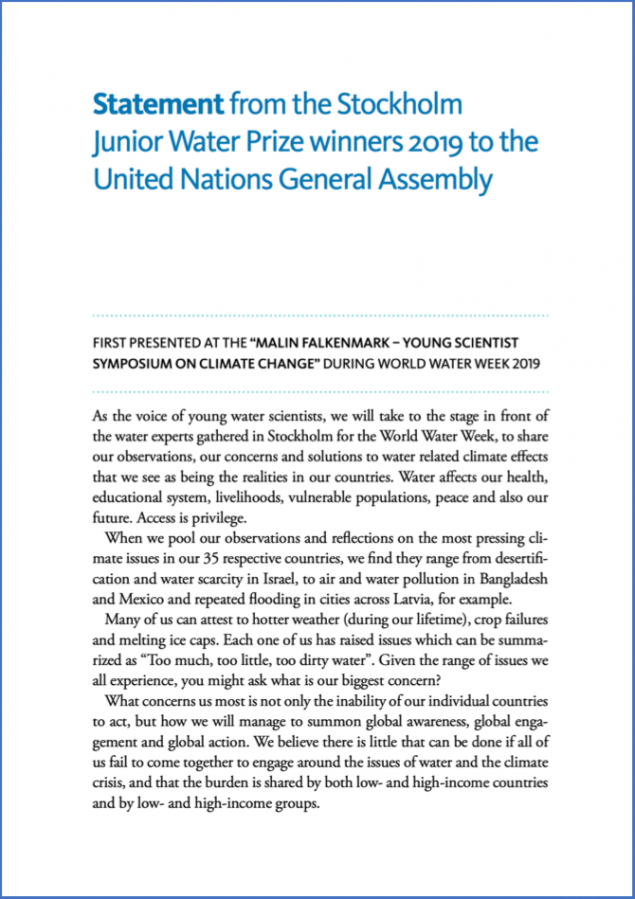
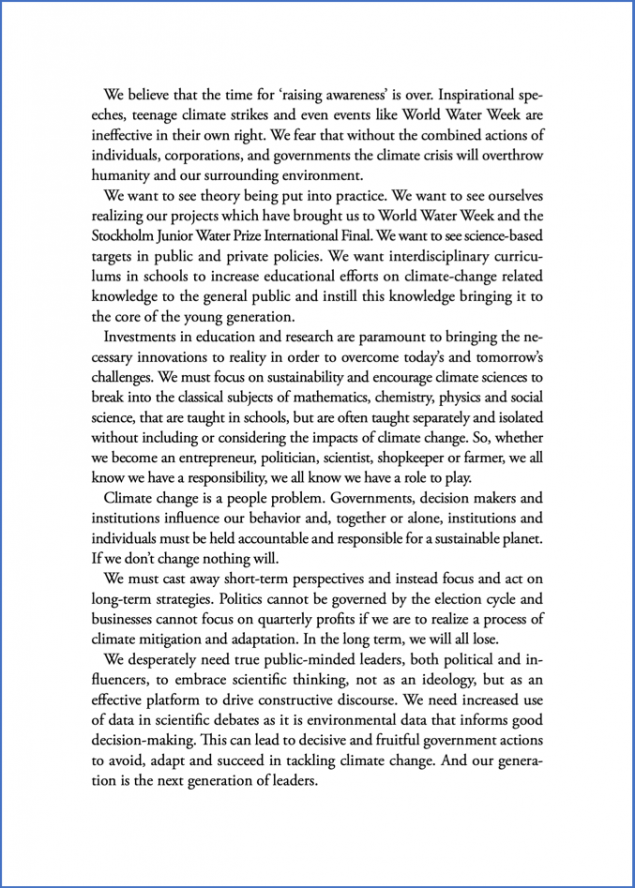
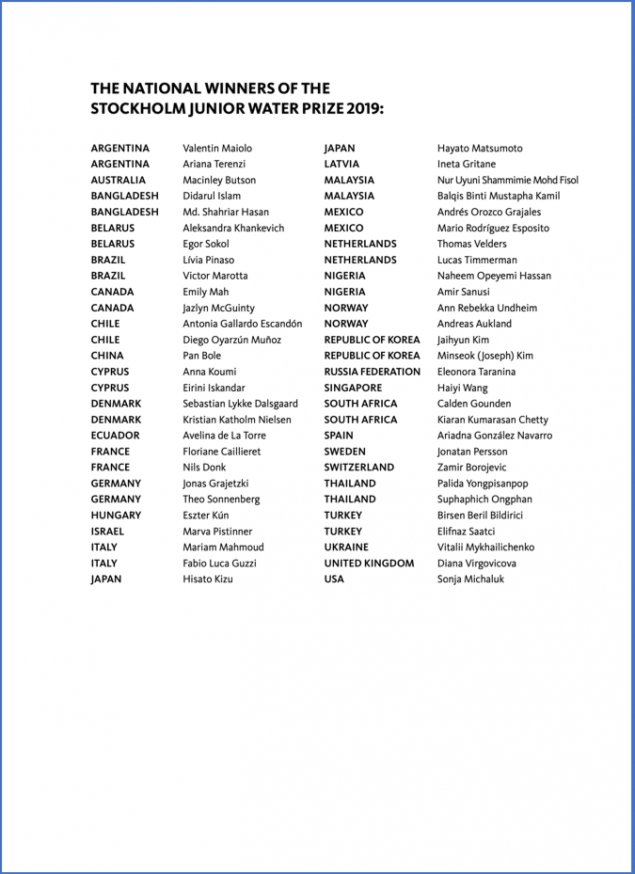
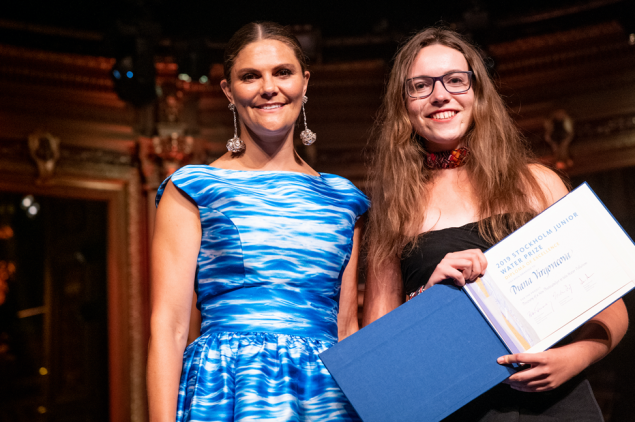
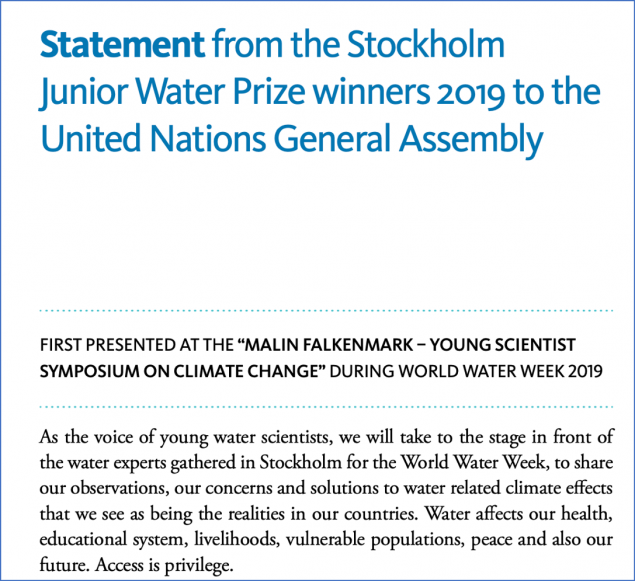



 Amanda Bielawski, Ph.D. (ABD), MS, MBA, is a conservation and sustainable development policy/communications consultant and researcher with a specific focus on global water security, environmental justice, Indigenous and Traditional Ecological Knowledge (ITEK), climate, and biodiversity. Bielawski has served in a variety of roles for the United Nations Development Programme’s (UNDP’s) Global Programme on Nature for Development, including fellow, consultant, researcher, and technical advisory committee member. Her research emanating from UNDP analyzes how 50 communities across 26 developing nations implemented Nature-Based Solutions (NBS) for water security. Bielawski has engaged in water and environmental peacebuilding training with entities including the Stockholm International Water Institute, UN Environment Programme, and Oregon State University’s Water Conflict Management and Transformation program. She began her career more than 20 years ago as a journalist covering ...
Amanda Bielawski, Ph.D. (ABD), MS, MBA, is a conservation and sustainable development policy/communications consultant and researcher with a specific focus on global water security, environmental justice, Indigenous and Traditional Ecological Knowledge (ITEK), climate, and biodiversity. Bielawski has served in a variety of roles for the United Nations Development Programme’s (UNDP’s) Global Programme on Nature for Development, including fellow, consultant, researcher, and technical advisory committee member. Her research emanating from UNDP analyzes how 50 communities across 26 developing nations implemented Nature-Based Solutions (NBS) for water security. Bielawski has engaged in water and environmental peacebuilding training with entities including the Stockholm International Water Institute, UN Environment Programme, and Oregon State University’s Water Conflict Management and Transformation program. She began her career more than 20 years ago as a journalist covering ...  Diana Virgovicova, 18, is a recipient of the 2019 prestigious Stockholm Junior Water Prize; she also received the 2019 Diploma of Excellence in recognition of her discovery of a photocatalyst that uses light waves to clean water, thus contributing to solving water pollution. At the age of 12, while living in a small Slovak village, Virgovicova became abruptly aware of climate change and its connection with rivers and water. Virgovicova is now completing A Levels (equivalent of U.S. high school) in London. She is currently developing her water-cleaning photocatalyst and hopes to soon distribute it to communities in developing nations, thus helping to improve water quality and related human health.
Diana Virgovicova, 18, is a recipient of the 2019 prestigious Stockholm Junior Water Prize; she also received the 2019 Diploma of Excellence in recognition of her discovery of a photocatalyst that uses light waves to clean water, thus contributing to solving water pollution. At the age of 12, while living in a small Slovak village, Virgovicova became abruptly aware of climate change and its connection with rivers and water. Virgovicova is now completing A Levels (equivalent of U.S. high school) in London. She is currently developing her water-cleaning photocatalyst and hopes to soon distribute it to communities in developing nations, thus helping to improve water quality and related human health. 
